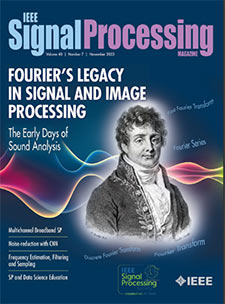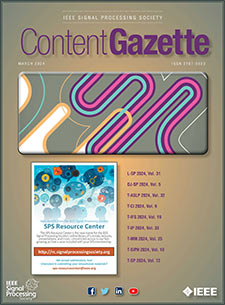- Our Story
- Publications & Resources
- Publications & Resources
- Publications
- IEEE Signal Processing Magazine
- IEEE Journal of Selected Topics in Signal Processing
- IEEE Signal Processing Letters
- IEEE/ACM Transactions on Audio Speech and Language Processing
- IEEE Transactions on Computational Imaging
- IEEE Transactions on Image Processing
- IEEE Transactions on Information Forensics and Security
- IEEE Transactions on Multimedia
- IEEE Transactions on Signal and Information Processing over Networks
- IEEE Transactions on Signal Processing
- IEEE TCI
- IEEE TSIPN
- Data & Challenges
- Submit Manuscript
- Guidelines
- Information for Authors
- Special Issue Deadlines
- Overview Articles
- Top Accessed Articles
- SPS Newsletter
- SigPort
- SPS Resource Center
- Publications Feedback
- Publications FAQ
- Blog
- News
- Dataset Papers
- Conferences & Events
- Community & Involvement
- Professional Development
- For Volunteers
- Information for Authors-OJSP
-
Home
Conferences14 April 2025 to 17 April 2025Conferences Events IEEE JSTSP Article IEEE Signal Processing Magazine IEEE TIFS Article IEEE TMM Article IEEE TSP Article Jobs in Signal Processing Lectures Machine Learning Seasonal Schools Signal Processing News SPM Article SPS Distinguished Lectures SPS Newsletter Article SPS Webinar SPS Webinars SPS Webinar Series Webinar webinars
-
Our Story
What is Signal Processing?

The technology we use, and even rely on, in our everyday lives –computers, radios, video, cell phones – is enabled by signal processing. Learn More » -
Publications & Resources
-
SPS Resources
- Signal Processing Magazine The premier publication of the society.
- SPS Newsletter Monthly updates in Signal Processing
- SPS Resource Center Online library of tutorials, lectures, and presentations.
- SigPort Online repository for reports, papers, and more.
- SPS Feed The latest news, events, and more from the world of Signal Processing.
-
SPS Resources
-
Conferences & Events
-
Community & Involvement
-
Membership
- Join SPS The IEEE Signal Processing Magazine, Conference, Discounts, Awards, Collaborations, and more!
- Chapter Locator Find your local chapter and connect with fellow industry professionals, academics and students
- Women in Signal Processing Networking and engagement opportunities for women across signal processing disciplines
- Students Scholarships, conference discounts, travel grants, SP Cup, VIP Cup, 5-MICC
- Young Professionals Career development opportunities, networking
- Get Involved
-
Technical Committees
- Applied Signal Processing Systems
- Audio and Acoustic Signal Processing
- Bio Imaging and Signal Processing
- Computational Imaging
- Image Video and Multidimensional Signal Processing
- Information Forensics and Security
- Machine Learning for Signal Processing
- Multimedia Signal Processing
- Sensor Array and Multichannel
- Signal Processing for Communication and Networking
- Signal Processing Theory and Methods
- Speech and Language Processing
- Technical Working Groups
- More TC Resources
-
Membership
-
Professional Development
-
Professional Development
- Mentoring Experiences for Underrepresented Young Researchers (ME-UYR)
- Micro Mentoring Experience Program (MiME)
- Distinguished Lecturer Program
- Distinguished Lecturers
- Distinguished Lecturer Nominations
- Past Lecturers
- Distinguished Industry Speaker Program
- Distinguished Industry Speakers
- Distinguished Industry Speaker Nominations
- Industry Resources
- IEEE Training Materials
- Jobs in Signal Processing: IEEE Job Site
-
Career Resources
- SPS Education Program Educational content in signal processing and related fields.
- Distinguished Lecturer Program Chapters have access to educators and authors in the fields of Signal Processing
- PROGRESS Initiative Promoting diversity in the field of signal processing.
- Job Opportunities Signal Processing and Technical Committee specific job opportunities
- Job Submission Form Employers may submit opportunities in the area of Signal Processing.
-
Professional Development
-
For Volunteers
-
For Board & Committee Members
- Board Agenda/Minutes* Agendas, minutes and supporting documentation for Board and Committee Members
- SPS Directory* Directory of volunteers, society and division directory for Board and Committee Members.
- Membership Development Reports* Insight into the Society’s month-over-month and year-over-year growths and declines for Board and Committee Members
-
For Board & Committee Members
Popular Pages
Today's:
- Submit a Manuscript
- (MLSP 2024) 2024 IEEE International Workshop on Machine Learning for Signal Processing
- Information for Authors
- (SLT 2024) 2024 IEEE Spoken Language Technology Workshop
- IEEE Transactions on Multimedia
- IEEE/ACM Transactions on Audio Speech and Language Processing
- IEEE Transactions on Information Forensics and Security
- IEEE Signal Processing Letters
- IEEE Transactions on Image Processing
- IEEE Transactions on Signal Processing
- (ICASSP 2024) 2024 IEEE International Conference on Acoustics, Speech and Signal Processing
- Conferences & Events
- Conference Call for Papers
- SPS Scholarship Program
- (ACSSC 2024) 2024 Asilomar Conference on Signals, Systems, and Computers
All time:
- Information for Authors
- Submit a Manuscript
- IEEE Transactions on Image Processing
- 404 Page
- IEEE/ACM Transactions on Audio Speech and Language Processing
- IEEE Transactions on Information Forensics and Security
- IEEE Transactions on Multimedia
- IEEE Signal Processing Letters
- IEEE Transactions on Signal Processing
- Conferences & Events
- IEEE Journal of Selected Topics in Signal Processing
- Information for Authors-SPL
- Conference Call for Papers
- Signal Processing 101
- IEEE Signal Processing Magazine
Last viewed:
- Information for Authors
- (SLT 2024) 2024 IEEE Spoken Language Technology Workshop
- Rich Baseil
- (MLSP 2024) 2024 IEEE International Workshop on Machine Learning for Signal Processing
- (SLT 2022) 2022 IEEE Spoken Language Technology Workshop
- (ICASSP 2024) 2024 IEEE International Conference on Acoustics, Speech and Signal Processing
- Call for Proposals: IEEE ASRU 2025
- Guidelines for Reviewers
- IEEE Transactions on Computational Imaging
- (ACSSC 2024) 2024 Asilomar Conference on Signals, Systems, and Computers
- Submit a Manuscript
- SPS SA-TWG Webinar: Maximum a Posteriori Penalty Function (MAP-PF) Multitarget Tracking
- (ME-UYR) Mentoring Experiences for Underrepresented Young Researchers Program
- Publications
- Publications & Resources
Kaewtip, Kantapon. University of California, Los Angeles(2017)"Robust Automatic Recognition of Birdsongs and Human Speech: a Template-Based Approach"
You are here
Newsletter Menu
Newsletter Categories
Top Reasons to Join SPS Today!
1. IEEE Signal Processing Magazine
2. Signal Processing Digital Library*
3. Inside Signal Processing Newsletter
4. SPS Resource Center
5. Career advancement & recognition
6. Discounts on conferences and publications
7. Professional networking
8. Communities for students, young professionals, and women
9. Volunteer opportunities
10. Coming soon! PDH/CEU credits
Click here to learn more.
News and Resources for Members of the IEEE Signal Processing Society
Kaewtip, Kantapon. University of California, Los Angeles(2017)"Robust Automatic Recognition of Birdsongs and Human Speech: a Template-Based Approach"
Kaewtip, Kantapon. University of California, Los Angeles(2017)"Robust Automatic Recognition of Birdsongs and Human Speech: a Template-Based Approach", advisor: Alwan, Abeer
This dissertation focuses on robust signal processing algorithms for birdsongs and speech signals. Automatic phrase or syllable detection systems of bird sounds are useful in several applications. However, bird-phrase detection is challenging due to segmentation error, duration variability, limited training data, and background noise. Two spectrograms with identical class labels may look different due to time misalignment and frequency variation. In real recording environments such as in a forest, the data can be corrupted by background interference, such as rain, wind, other animals or even other birds vocalizing. A noise-robust classifier needs to handle such conditions. Similarly, Automatic Speech Recognition (ASR) works well in quiet environments, but a large degradation in performance is observed when the speech signal is corrupted by background noise. The ASR performance would benefit from robust representations of speech signals and from robust recognition systems.
The first topic of this dissertation focuses on an automatic birdsong-phrase recognition system that is robust to limited training data, class variability, and noise. The algorithm comprises a noise-robust Dynamic-Time-Warping (DTW)- based segmentation and a discriminative classifier for outlier rejection. The algorithm utilizes DTW and prominent (high energy) time-frequency regions of training spectrograms to derive a reliable noise-robust template for each phrase class. The resulting template is then used for segmenting continuous recordings to obtain segment candidates whose spectrogram amplitudes in the prominent regions are used as features to a Support Vector Machine (SVM). In addition, the authors present a novel approach to training HMMs with extremely limited data. First, the algorithm learns the Global Gaussian Mixture Models (GMMs) for all training phrases available. GMM parameters are then used to initialize state parameters of each individual model. The number of states and the mixture components for each state are determined by the acoustic variation of each phrase type. The (high-energy) time-frequency prominent regions are used to compute the state emitting probability to increase noise-robustness.
The second topic of the dissertation deals with noise-robust processing for automatic speech recognition. The authors also propose a new pitch-based spectral enhancement algorithm based on voiced frames for speech analysis and noise-robust speech processing. The proposed algorithm determines a time-warping function (TWF) and the speaker's pitch with high precision, simultaneously. This technique reduces the smearing effect in between harmonics when the fundamental frequency is not constant within the analysis window. To do so, the authors propose a metric called the harmonic residual which measures the difference between the actual spectrum and the resynthesized spectrum derived from the linear model of speech production with various combinations of TWF and high-precision pitch values as parameters. The TWF and pitch pair that yields the minimum harmonic residual is selected and the enhanced spectrum is obtained accordingly. The authors show how this new representation can be also used for automatic speech recognition by proposing a robust spectral representation derived from harmonic amplitude interpolation.
Open Calls
Conference News
Chapter & DL News
PhD Theses
- Zhu, Zhenghan. University of Rhode Island (2017)"Some Contributions to Radar Detection Theory"
- Hossein Bashashati, University of British Columbia (2017) "A User-Customized Self-Paced Brain Computer Interface"
- Tralie, Christopher J.. Duke University(2017) "Geometric Multimedia Time Series"
- Jang, Hyungseok. (The University of Wisconsin - Madison), "Advances in Single Point Imaging for Electron Paramagnetic and Magnetic Resonance Imaging” (2017)
- Wisler, Alan. Arizona State University, (2017) "Graph-based Estimation of Information Divergence Functions"
Initiatives & Trends
Member Highlights
News & Announcements
Education & Resources
SPS on Twitter
- DEADLINE EXTENDED: The 2023 IEEE International Workshop on Machine Learning for Signal Processing is now accepting… https://t.co/NLH2u19a3y
- ONE MONTH OUT! We are celebrating the inaugural SPS Day on 2 June, honoring the date the Society was established in… https://t.co/V6Z3wKGK1O
- The new SPS Scholarship Program welcomes applications from students interested in pursuing signal processing educat… https://t.co/0aYPMDSWDj
- CALL FOR PAPERS: The IEEE Journal of Selected Topics in Signal Processing is now seeking submissions for a Special… https://t.co/NPCGrSjQbh
- Test your knowledge of signal processing history with our April trivia! Our 75th anniversary celebration continues:… https://t.co/4xal7voFER
Home | Sitemap | Contact | Accessibility | Nondiscrimination Policy | IEEE Ethics Reporting | IEEE Privacy Policy | Terms | Feedback
© Copyright 2024 IEEE – All rights reserved. Use of this website signifies your agreement to the IEEE Terms and Conditions.
A not-for-profit organization, IEEE is the world's largest technical professional organization dedicated to advancing technology for the benefit of humanity.







